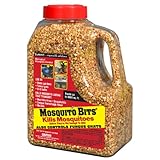I don't bother with most "pests" in the yard unless they are destroying something or pose a risk. I let the spiders make their webs, the bees build their nests in the trees, the unnamed cats live in the barn, and the deer eat from the orchard. However, I just can't stand the darn mosquitoes! They ruin the outdoors making an evening on the porch unbearable. If they get the dog his eyes swell and the bites leave the kids with itchy welts that last for weeks. We were just sick of swatting at every little tickle we thought was a tiny vampire landing on our skin preparing for their meal.
Over the past few years I've steadily ramped up my approach to dealing with the pests and I think I've finally got a system that is both effective and safe. Things are better now, the thought of retreating and nuking the site from orbit no longer crosses my mind.
So without further delay I hereby present you with:
THE
"What I'm Currently Doing to Control Mosquitoes"
PLAN
PLAN
A large area, multifaceted approach is the best way deal with any mosquito population. Even though it may be a bit more costly up front to get the supplies you need for a broad spectrum attack; you will save money by not continually treating a renewing population. The aim is to treat all stages of growth; larvae, adolescent, and adult. If you only apply a knockdown agent for the adults, like malathion, your problem will probably be back in a week as the next brood matures.
Mosquitoes lay their eggs in water or moist areas. It's very important to clean up any standing water. Dump out any buckets, bowls, flower pots, check gutters, etc. Treat swampy and moist areas and any standing water you can't dump with BTI bacteria. This type of bacteria can be found in liquid form (with a shelf life of about 1 year) or in granular or floating ring style, commonly called, "Mosquito Bits" and "Mosquito Dunks", respectively. BTI is a naturally occurring bacillus that releases toxins into the gut of larvae. Mosquito eggs laid in water are clumps or individual larvae that float just below the water's surface and extend a breathing tube to the air above. If you can do something to break up the surface tension of standing water it could also cause these egg rafts to sink and if it forms a film like soap or oil it would prevent larvae from getting air with their breathing tubes.


For the adult population I spray Bifenithrin in a 7.9% concentration. Bifen IT, the brand of bifenithrin I use, is a pyrethroid. Pyrethroids are man made versions of pyrethrins, which come from concentrations extracted from dalmatian chrysanthemum flowers. This particular brand uses a wax emulsion to help retain a residual of the application when exposed to rain. It has a rated residual of about 3 months but I find an application about every 6 weeks seems to be more effective depending on how precipitation has trended. Always spray when it's dry and no rain is forecast for the next 24 hours.

If I'm spraying the first application of the year I add an insect growth regulator to my pyrethroid. I use NyGuard to keep the adolescent mosquitoes from maturing into adults, this prevents them from growing to the point where they are capable of reproducing. This product has a long residual so there may be no need to add it to subsequent pyrethroid applications. If you are using malathion never mix NyGuard with it as this will reduce the effectiveness of both. I've moved away from using Malathion in recent years. Malathion is inexpensive, safe, and can be found in many home stores but it has a low residual and is a little less 'natural' than Bifenithrin.

Solo Sprayer
Stihl 450 Backpack Sprayer/Duster
I always work the property starting down wind so the natural air currents help distribute the spray into thick foliage and away from my body. Labels state that the application area for these chemicals is safe for pets and children after 30 minutes. Note: Many of these chemicals are toxic to fish and cats. I usually conduct my spraying when day activities are done in the evening, the mosquitoes are more active and I can let the application sit overnight.
I hope this information helps and that you might be able to adapt these tips to your own budget and landscape. Please follow all directing on the labeling for any product you use and be sure to wear the proper personal protection equipment when handling any chemicals.


